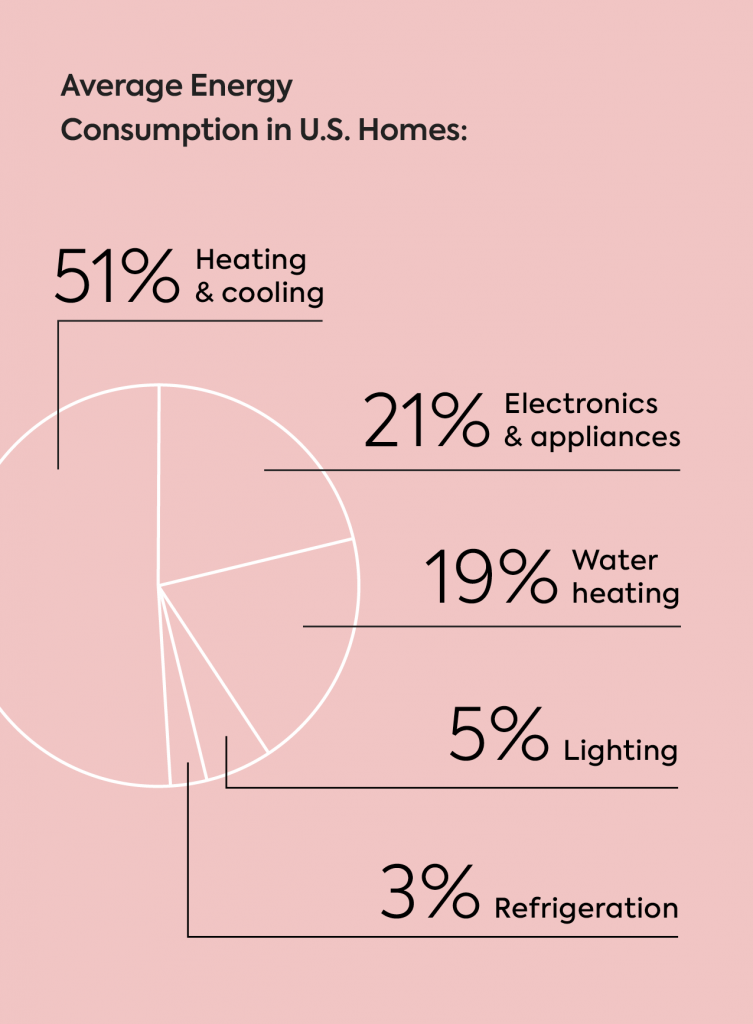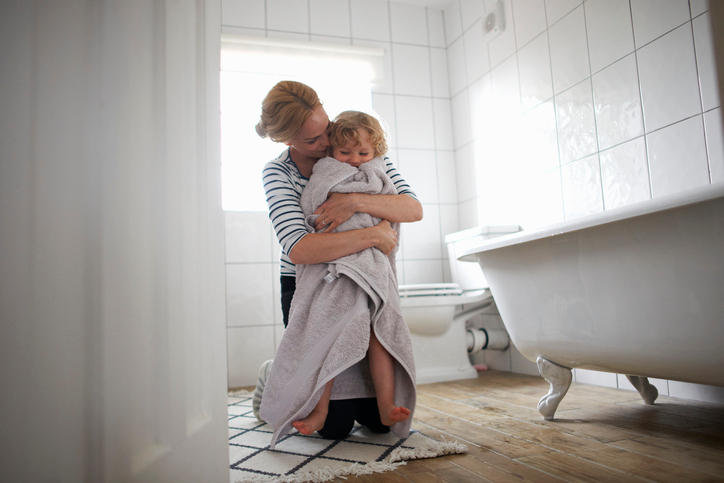We all know conserving energy is important… but why? And what are the best and easiest ways to save energy at home?
If you’re looking for tried-and-true ways to save energy at home, you’ve found the right corner of the internet.
(It’s true! Hi, we’re Sealed, and we’re Home Energy Experts. If you’re ready to save energy, we’re here to help!)
In this article, you’ll cover:
- Why should you conserve energy at home?
- Why is saving energy important?
- What is the BEST way to save energy at home?
- 52 tips for saving energy in daily life
- How to get energy-saving upgrades at no upfront cost
Why should we conserve energy at home?
Conserving energy is not only good for the health of Mother Earth, but it can also be an excellent way to improve your own health and reduce energy costs at home.
When you take steps to conserve energy at home, you’re reducing:
- Your monthly energy costs
- Your reliance on fossil fuels
- Your carbon footprint
- The environmental impact that energy production has on your community
- Greenhouse gas emissions, and that directly helps with climate change
- The risk of an insecure or unreliable energy supply (which can lead to rationing, heating emergencies, and big energy cost price spikes)
- Your impact on our aging energy infrastructure (aka grid), which can reduce service outages
But conserving energy at home does more than reduce negative impact. It also can increase:
- Jobs and economic growth through new technology, like heat pumps, wind turbines, and home solar
- Your house’s ability to withstand extreme weather more safely (with energy-efficient home weatherization)
- Your (and even your pet’s) physical health by reducing fossil fuel use at home—or giving them up altogether—and increasing your indoor air quality
- Improvements in your community’s outdoor air quality
On average, 51% of your energy use at home is for heating and cooling alone.
Why is saving energy important?
Conserving energy helps reduce our reliance on finite resources—like fossil fuels, including natural gas, propane, and oil—which are limited in supply and expensive to produce.
Plus, extracting, refining, and burning fossil fuels also damages the environment, so using less energy as a whole is gentler on our planet.
Even if you only use electricity in your home, some portion of your electricity is likely generated by fossil fuels—unless your house runs on solar energy or you’ve opted into using renewable energy alone. That means using electricity wisely is important, too!
All in all, saving energy can help us create a more sustainable future. But what are the BEST ways to save energy at home?
Let’s talk about that next. (Then, we’ll jump into practical ways you can reduce your energy use in your daily life.)
Even if you only use electricity in your home, some portion of your electricity is likely generated by fossil fuels—unless you’ve opted into using renewable energy alone.

What is the BEST way to save energy at home?
This may come as a surprise, but the best way to reduce your energy use at home isn’t about turning off lights or taking shorter showers. (Although that can help a bit!)
Heating and cooling your house to keep it comfortable uses the most energy at home. In fact, 51% of your energy use is used for heating and cooling alone (1).
So the best way to meaningfully reduce energy use is to find and fix any energy waste in your house’s main airflow and comfort issues. (Things like a too-hot upstairs, really cold floors, a stuffy house, humidity problems—all of these comfort and airflow issues are directly related to energy waste, too.)
Here’s how to do it:
- Make sure your home has sufficient insulation for your climate.
Most don’t: 90% of U.S. houses are under-insulated (2). And it is especially important to have enough attic insulation, due to a building science principle called the stack effect. - Professionally close up all the air leaks that allow your paid-for heating and cooling to escape.
Air leaks can cause up to 40% loss in your house’s heating and cooling energy (3). Every home has them: open gaps, cracks, and seams that take in outside air year round and make your HVAC system work harder. Sealing them up can not only conserve energy you use to heat and cool your home, but it can also reduce moisture, humidity, and allergen problems. - Switch to modern heat pump HVAC technology to save even more.
Super-efficient heat pumps can both heat and cool your home, keeping it comfortable year round, up to 3 times more efficiently than traditional HVAC systems (4).
Heat pumps also improve your home’s air quality by removing fossil fuel heating from your home and filtering the air all year. They’re the best way to keep your home feeling great while wasting less energy in the smartest way possible, which is why we affectionately like to call them the Tesla of HVAC.
Heat pumps are the best way to keep your home comfortable while wasting less energy.
If these three fixes don’t sound as exciting as a redone kitchen or finally finishing that man cave or she shed, we get it.
But these improvements work—and they’re powerful: In our experience, we’ve seen doing these upgrades together can reduce a home’s energy use by 50%.
(Not to mention, they provide a whole host of other benefits like extending the life of your roof, improving air quality, creating a healthier home, stopping moisture intrusion, and so much more.)
Get our FREE in-depth guide to home comfort and efficiency. Bonus case studies and checklists are included!
52 tips for saving energy in daily life
Let’s dig into 52 ways to save energy at home in your everyday routine.
These tips are a great first step if you’re a renter or aren’t ready for big home improvements just yet.
They’re also a great way to conserve even more energy if you’ve already fully weatherized your home or switched to an energy-saving heat pump!
We’ve separated them by topic to make them easy to navigate:
- Ways to save energy on hot water use
- Tricks to conserve energy when doing laundry
- Unique, fun ways to save energy at home
- Tips to save energy in the kitchen
- Ideas for conserving energy throughout the house
- Ways to reduce energy used to heat and cool your home

3 ways to save energy on hot water use
- Use less hot water. Create a plan that works for you. It can be as easy as lowering the temperature on your water heater or as committed as taking shorter showers. Just under 20% of a home’s average energy consumption is for hot water alone, which can have a big impact (5).
- Turn down (or off) your water heater when going on vacation. That way, your water heater can take a vacation, too!
- Insulate your visible hot water pipes! Water pipes near and around your water heater can be insulated to help reduce heat loss. This is an easy, inexpensive fix if you have access to the piping.
4 tricks to conserve energy when doing laundry
- Use a high-efficiency (HE) dryer for your clothes—it turns off when your clothes are dry. That way, it’s not unnecessarily running a longer cycle based on a timer. (Or use the lowest time on your older dyer and only add extra time if needed.)
- Hang dry clothes outside on nice days. Speaking of drying clothes, this old-fashioned trick saves energy, makes your clothes last longer, and helps them smell amazing, too.
- Use cold water to wash your clothes. Use the lowest temperature setting for your laundry. (It’s easier on your clothes, too!) Newer washing machines and laundry soaps make cold water more effective at cleaning your clothes than hot water.
- Try a spin-only (a no-heat) dry cycle in your clothes dryer, or use a spin dryer to cut down on your clothes-drying time. A spin dryer uses significantly less energy and can cut the use of your clothes dryer by 30 minutes!

2 unique, fun ways to save energy at home
- Use technology to encourage energy conservation at home. There are plenty of apps and calculators out there to help you discover where you can cut the most energy waste in your home based on your unique use patterns. Some apps, like GridRewards, will even pay you to use less energy during peak-use times!
- Have monthly “blackout nights” at home. This can be especially fun if you have kids. Make it a competition and review your month-over-month energy differences! Turn off all appliances and electronics in your home for 24 hours (that are safe to—leave your refrigerator running and that heater on if you’re in a blizzard, of course). And… play a board game by candlelight, cook on an open flame outdoors, read books by flashlight, and have a night of “camping in.” Bonus: It’s all screen-free.
7 tips to save energy in the kitchen
- Microwaves save more than just time. Using your microwave to warm-up food or do a quick veggie steam can use less energy than turning on your oven or stovetop.
- Use your oven light instead of opening and closing the oven door. Love to see those rolls in the oven rising? Turn on your oven light! Opening and closing the door to check on your food wastes energy. Set a timer and check on your food once it’s close to being done.
- Cool down any hot food before putting it in your refrigerator or freezer. (That extra heat causes your refrigerator to work harder!)
- Fill your dishwasher as close to full—and then run it. Don’t run a half empty dishwasher! Load it on up.
- Skip preheating your oven. Does that sound like an unusual tip? Most foods don’t necessarily need to wait until your oven is preheated. Go ahead and add your meal at the start of your oven and monitor the time. (Keep food safety in mind here, though!)
- Replace an older refrigerator with an ENERGY STAR-rated upgrade. Older refrigerators waste a lot of energy. Refrigeration makes up about 3% of your home’s energy use, but an older fridge can be a real energy-waster (6).
- Turn off your stove or oven toward the end of cooking time. Your food can continue to use the heat energy from the pan or stored in the oven to finish cooking. (Keep food safety in mind, however!)

12 ideas for conserving energy throughout the house
- Upgrade to smart power strips. Never heard of a smart power strip? Check them out. They can help reduce energy use from devices that are plugged in but not in use, like your home office electronics. This waste is often called a vampire load, and it can cost you up to $200 a year in energy use (7).
- Upgrade to energy-efficient lighting. If you haven’t made the switch to LED lightbulbs yet, well, it’s about time. Using energy-efficient lightbulbs and trading out older light fixtures for ENERGY STAR-rated lighting can help. But lighting only makes up about 5% of your home’s total energy use, so the energy savings will be minimal (8). (But you should still go for it! That can add up over time.)
- Upgrade from single-pane windows to double-pane. This is a really expensive project, one that most homeowners won’t fully recoup the cost of for years to come. Although going from single-pane to double can save you some energy, you’ll still need to air seal your new windows, too. (If you like your windows and want to preserve them, go for air sealing and insulation instead to stop drafts for good.)
- Transition to energy-efficient appliances. The non-HVAC and non-refrigeration appliances in your home—like your dishwasher, oven, washer and dryer, and entertainment systems—use about 21% of your total energy consumption (9). Upgrading to newer, more modern appliances can reduce this energy load.
- Turn off electronics when not in use. No explanation needed here!
- Unplug electronics whenever possible. This goes back to the idea of a “vampire load,” and unplugging things like your toaster, heating pad or blankets, and coffee maker when not in use.
- Use lighter paint colors indoors. It helps natural light expand in a room, requiring you to use less electric lighting.
- Open your blinds and curtains. Use natural light as much as possible.
- Clean the filters in your house—all of them. Your HVAC filter, your dishwasher filter, your clothes dryer filter. Every single one. This keeps your appliances operating efficiently.
- Turn off the lights when you leave a room. This sounds like a no-brainer, but it’s a good reminder!
- Use energy-efficient appliances, like ENERGY STAR-rated models. If you have a choice between a new microwave and a new ENERGY STAR microwave model, go with ENERGY STAR.
- Have your major appliances regularly maintained. Heating and cooling systems should be checked every year, and refrigerators, washers, dryers, and dishwashers need maintenance too. Dust coils, replace seals, clean filters, and drain drain lines for optimum energy performance.
24 ways to reduce energy used to heat and cool your home
Remember, heating and cooling your house requires the most energy use out of all your daily activities, so it makes sense that this section is the longest list of tips you’ll get!
- Replace your HVAC filters regularly. A dirty HVAC filter can cause your whole system to run less efficiently. Replace these at least every 90 days or according to your HVAC system’s directions.
- To keep a room from getting stuffy, use the ceiling fan instead of lowering the thermostat. Ceiling fans use about 0.018 kilowatt hours (kwh) of electricity on average, compared to 0.48 kwh to 5.14 kwh for central AC (10, 11).
- Use thermal blankets on cold nights. A thermal blanket uses less energy than a space heater. Depending on the setting used, thermal blankets use about 0.20 kWh versus the 1.5 kWh of a space heater (12. 13). But remember to keep safety considerations in mind with both!
- Make sure your HVAC system is correctly sized. (That includes any HVAC appliances you add to your central system, like a window unit or a mini-split for an addition.) Get professional help from an HVAC tech if needed. An oversized or undersized appliance is sure to waste energy.
- Install a smart thermostat. Upgrading to a smart thermostat is an easy way to reduce energy use throughout the day. Learn more in our Ultimate Guide to Smart Thermostats. Tap here to learn how to install a smart thermostat.
- Install thermal curtains. A big win for renters: Thermal curtains can actually work to provide extra insulation around your windows—and that helps keep out heat in the summer and cold in the winter. And when you’re keeping outside temperatures out, you’re less likely to turn up or down your HVAC system to stay comfy. (Air sealing can permanently stop window drafts, but thermal curtains can add a non-permanent additional layer of insulation if you need it, unlike plastic window insulation kits.)
- Insulate your crawl space. As one of the most forgettable parts of the home, you probably don’t think about your crawl space much if you have one. However, insulating this area can keep your paid-for heating and cooling inside your home.
- Use draft blockers—and not just in winter. As a quick fix, use a door snake, sometimes called a draft blocker or draft guard, to reduce drafts along the bottoms of your doors and windows. Draft blockers can reduce the likelihood you’ll overwork your HVAC system, which reduces energy use.
- Seal up air leaks in your home. We already mentioned this in the BEST ways to save energy at home section above, but in case you missed it: Every house has air leaks that allow outside air to get in (and inside air to get out). Closing these up can reduce energy use. Get air sealing at no upfront cost. Learn how.
- Insulate your basement walls. Same here: Basement insulation is key to making your whole house more efficient and comfortable, even if you don’t use it and only the spiders hang out down there.
- Weatherize your home from top-to-bottom. This is where whole-home insulation, air sealing, and even HVAC upgrades work together to really help you save energy. But you can get started by adding fresh weatherstripping to doors, windows, and attic entrances around your home. (And weatherstripping is something renters can do, too! It’s fairly affordable.)
- Make sure windows and doors are closed. When your heating or cooling system is on, make sure you haven’t left a window open somewhere! That automatically equals waste.
- Close air vents in unused rooms. This is an easy, quick tip. If you don’t use your office much or if one bedroom stays empty until your in-laws visit, close the vent so air is redirected to other parts of the house.
- Turn down (or off) your heating or cooling system when on vacation. Make sure to not completely turn off your heating system if there are risks of pipes freezing where you live.
- Use your ceiling or box fans, but turn them off when you’re not in the room. Fans don’t actually cool a room; they simply circulate air to make a room feel cooler to your skin. And they can recirculate heat that rises to the ceiling in the winter throughout a room.
- Fix duct leaks. Up to 30% of the air in your central HVAC system is lost due to leaks, holes, and poorly connected ducts (14). Use a flashlight to see if you can find any open seams or gaps in exposed ducts, and go after them with duct tape. (That’s what it’s for!)
- Regularly clean ac coils in your air conditioning system so it runs more efficiently.
- Add fresh weatherstripping to your doors and windows. This is just one small step for a properly weatherized house.
- Seal up your fireplace when it’s not in use to keep drafts from coming in. You can close the flue, use a chimney blocker or balloon, or have a professional help seal it.
- On days with great weather, shut off your HVAC system and open your windows. Enjoy the fresh air!
- On sunny winter days, open up curtains and shades and allow for the sun to warm up your home. Close blinds and shades to trap that heat in before sundown.
- In the summer, leave blinds or shades closed to keep extra heat out. Or install a solar film for a little extra UV reduction while keeping your blinds open.
- Open bedroom doors upstairs whenever possible to allow central air to circulate more efficiently.
- Wear seasonal clothing. This seems like a no-brainer, but wearing a sweater on cold days and wearing lighter clothing on warm days (even if you’re staying indoors) can reduce the need to turn up and down your thermostat, which conserves energy!
We’re big fans of using energy as efficiently as possible—it’s our area of expertise, after all—and tips like this can help.
But at Sealed, we believe you should be able to cut energy waste significantly without turning your daily life upside down, piling on a bunch of sweaters, or doing a monthly “blackout night,” however fun that might be for some…
…So we created a hassle-free way of cutting energy waste at home every day.
At Sealed, we believe you should be able to cut energy waste significantly without turning your daily life upside down.
Get energy-saving upgrades at no upfront cost with Sealed
If your house qualifies to work with Sealed, we complete a (free!) remote energy assessment of your house to scope out which parts of your home are wasting the most energy.
And then we create a customized plan to fix it with upgrades like high-performance insulation, professional air sealing, home weatherization, and electric heat pumps.
You pay us back for the improvements with a flexible payment plan that works best for you and your budget.
Sounds too good to be true? It’s not!
Complete our easy, 2-minute questionnaire to see if your house qualifies to work with Sealed.